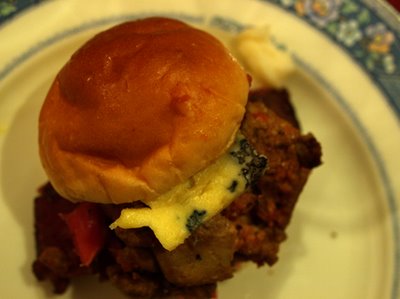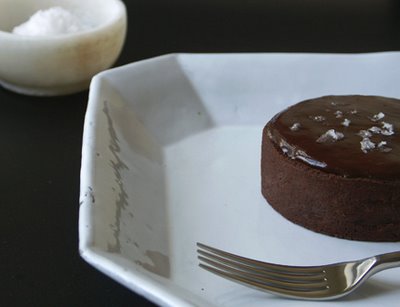 It was a burger that was simple in concept but daring in use of ingredients. An almost dainty brioche bun barely holding together slices of Wagyu tataki, Bachi Otoro Sashimi, pan-seared foie gras and blue cheese. The otoro was unexpected initially because I did not read the menu and thought I was mistakenly served a fish sandwich, but soon enough the wagyu, the foie and the cheese asserted themselves and the result was one happy meaty party. Excessive? Maybe, but seriously, I could have eaten another ten pieces. Image Credit: Foie Gras Dinner by u m a m i via Casey
It was a burger that was simple in concept but daring in use of ingredients. An almost dainty brioche bun barely holding together slices of Wagyu tataki, Bachi Otoro Sashimi, pan-seared foie gras and blue cheese. The otoro was unexpected initially because I did not read the menu and thought I was mistakenly served a fish sandwich, but soon enough the wagyu, the foie and the cheese asserted themselves and the result was one happy meaty party. Excessive? Maybe, but seriously, I could have eaten another ten pieces. Image Credit: Foie Gras Dinner by u m a m i via CaseyOf E.coli, Foie Gras, Boomer Bellies, And 'Gastroporn' - 2007. Oh, and did we happen to mention "reverse-dieting", Izakayas, mangosteen, and "fatty acid profile"?
It is never easy to predict trends in our cultural experience, especially when it comes to the gastronomic variety.
Some trends might be easy ... like, be careful around packaged vegetables such as Spinach or Lettuce.
Other trends might require a more tactile approach to detect - as in being a little more experimental while dining out.
Surfice it to say, be free to eat and experiment in 2007 for there are many areas in which to explore where food-creativity meets one's needs. Here are a few predictions for 2007 as to what one might run into while eating through the coming year!
Excerpts from The Atlanta Journal-Constitution –
PREDICTING 2007 TRENDS IN FOOD
Ethiopian bread will be popular this year. Check out what else will be on our plates.
By CHRIS ROSENBLOOM and SUSAN PUCKETT - The Atlanta Journal-Constitution - Published on: 01/04/07
"It's hard to make predictions, especially about the future," goes an often-quoted saying.
But that doesn't stop us from trying.
With last year's focus on the dangers of trans fats, will we see more interest in good and bad fats in 2007?
With sodium levels skyrocketing in convenience products and restaurant items, could salt be the next villain?
----
How will food marketers take advantage of baby boomers' abundant disposable income as they go kicking and screaming into old age?
To answer these questions and others about what we can expect to see on our tables and in the marketplace in the coming year, we consulted experts across the country and perused the piles of magazines, press releases and new books that have already weighed in.
Here's what they were seeing in their crystal balls:
Anti-aging products for boomers
"Food products will be moving beyond liquid drinks like Ensure or Boost in marketing to older adults," says Dea Baxter, associate professor of nutrition at Georgia State University. Superfruits or their extracts like açaí, goji berry, coffee berry, guava and mangosteen will appear on a host of ingredient lists from drinks to desserts. They're loaded with disease-fighting anti-oxidants and especially appealing to older consumers. "Packaging innovations will also be implemented for older adults with arthritis or decreased grip strength," Baxter adds.
'Bellies are big'
So notes restaurant consulting firm Joseph Baum & Michael Whiteman Co. in its forecast for 2007. "Relentlessly searching for new things to serve, chefs are focusing on the nether regions of fish and animals," according to the report. Pork belly, better known as bacon, was big on menus everywhere last year, and costly tuna belly, also known as toro, was popular in upscale sushi restaurants. This year, they say, menus will feature veal, salmon, swordfish and lamb bellies — "all rich with fatty flavor, all (not coincidentally) cheap cuts that used to be trimmed away."
 A 2007 prediction list "Two-Fer" - Chocolate Caramel Tartlettes with Sea Salt. Image Credit: Nordljus
A 2007 prediction list "Two-Fer" - Chocolate Caramel Tartlettes with Sea Salt. Image Credit: NordljusChocolate - the darker, the better [goes without saying]
Chocolate is no longer a guilty pleasure as researchers identified that dark chocolate contains compounds called flavonols that provide heart-healthy benefits.
----
We will see more chocolate products from Ecuador, Venezuela and the Ivory Coast as competition for the 'best' chocolate grows."
Downsized desserts
Simple carbs are still on the no-no list for many a calorie-conscious eater.
----
Seasons 52, the health-oriented chain that opened two locations here last year, serves teeny portions of red velvet cake and Key lime pie; Rathbun's pastry chef Kirk Park offers mini samples of his entire dessert menu all on one plate - a trend in and of itself.
Exotica goes everyday
"Foods unfamiliar to everyday shoppers, like Greek yogurt, jicama from Mexico, Japanese sushi rice and Portuguese peri-peri sauces, will be front and center in the gourmet groceries that spring up in newly developed areas," according to "Next Now" (Palgrave Macmillan, $26.95). "Here, trendy shoppers will visit tasting bars and attend cooking classes." Asian flavors and African specialties such as injera, the soft Ethiopian bread that serves as an eating utensil, are likely to be big in such shops.
'Feel-good fish'
That's how Bon Appétit describes the fish that's in favor now in its January 2007 issue: environmentally sound, and low in toxins and PCBs. Among the eco-friendly varieties it recommends: United States- and Central American-farmed tilapia, wild mahi-mahi from Hawaii, the Atlantic and Gulf of Mexico; California-farmed sturgeon; American-farmed striped bass.
 Mackerel is torched at the table at Musha in Santa Monica. Image Credit: Monica Almeida/The New York Times
Mackerel is torched at the table at Musha in Santa Monica. Image Credit: Monica Almeida/The New York Times'Gastroporn' invades the lexicon
Now that EVOO - Food Network icon Rachael Ray's catchword for extra-virgin olive oil - has made it into the Oxford American College Dictionary, could this term that's begun popping up everywhere be far behind?
----
"The preparing, cooking, tasting and eating of food have become voyeuristic pleasures separated from physical reality."
Hamburgers and hot dogs go haute
Speaking of Ray, she is expanding her empire to include a hamburger restaurant, as is Mario Batali's partner Joe Bastianich, who's planning one serving sustainable beef, according to consulting firm Joseph Baum & Michael Whiteman Co. (Here in Atlanta, Shaun Doty uses super-high-end Japanese wagyu beef at Shaun's, Star Provisions continues to sell its foie gras burger to go, Jöel makes its lunch burger with Kobe beef and Midtown's Repast last year rolled out a foie gras hot dog.) "Perhaps they're inspired by Hubert Keller's Burger Bar in Las Vegas, where, in addition to a standard hamburger, you can blow your winnings on a $60 Rossini Burger of Kobe beef, foie gras and truffles," they say.
Izakayas as the next small-plate cuisine
The Japanese version of tapas bars is opening all over the world, notes Joseph Baum & Michael Whiteman Co. "These are homey places emphasizing modestly priced Japanese hors d'oeuvres washed down with oversize bottles of beer and overfilled glasses of sake," the consultants say.
 "Musha" in Santa Monica, Calif., is an izakaya, or pub. The small dishes in izakayas typically come in traditional forms of tempura, simmered dishes called nimono and grilled dishes like yakitori skewers. Image Credit: Monica Almeida/The New York Times
"Musha" in Santa Monica, Calif., is an izakaya, or pub. The small dishes in izakayas typically come in traditional forms of tempura, simmered dishes called nimono and grilled dishes like yakitori skewers. Image Credit: Monica Almeida/The New York Times----
They note that the P.F. Chang's folks have opened a more Americanized version in Scottsdale, Ariz., that, if successful, could launch another chain. Look for the Kinjo brothers, creators of Midtown's MFSushibar and Nam, to open their version soon.
Junk food made over
Fiber-packed fruits and vegetables are being made into chips, ice cream is being enhanced with extra vitamins, whole grains and heart-healthy oils are replacing white flour and trans fats in cookies, and even Disney is putting a more nutritious spin on its theme-park snack foods.
Kid-aimed food advertising
Trend-spotter Salzman calls children the "masters of pester power" who are easily won over with sweet, colorful foods presented in fun formats, making them a much-sought-after target for advertisers across the globe.
Locally grown food
As concerns about food safety and the environment grow, so does the popularity of farmers markets and foods produced close to home. "Consumers want to know where and how food is being grown," says Patti Garrett, a nutrition instructor at Georgia State University. She points to the Atlanta Local Foods Initiative as an example. "This group helped in the distribution of a local foods guide published from Georgia Organics to promote local foods, decrease transportation costs, maintain and improve crop diversity in Georgia and support community gardens." A copy of the guide can be found online at www.buylocalgeorgia.org.
Mad science meets fine dining
Though the trend has yet to take off here, in a growing number of big-city kitchens, chefs are dismantling the molecular structure of fresh ingredients - "whirling them in laboratory equipment with frightening-sounding chemicals, dipping them in liquid nitrogen, inflating them with vacuum cleaners, fabricating cantaloupe caviar, deep-frying mayonnaise, turning sauces into powders, and spraying the air with flavors to suggest that what you're looking at isn't what you're about to eat," according to Joseph Baum & Michael Whiteman Co. Richard Blais began dabbling at it at his eponymous Blais here in Atlanta; now Hector Santiago of Pura Vida is planning to unleash his own experiments at his upcoming Bodega Gastronomica.
Newfangled steakhouses with name chefs
Wolfgang Puck, Bradley Ogden, Michael Mina and David Burke are among the celebrity chefs who have launched "newfangled beeferies that marry elements of serious cooking with simple but upscale grilling," according to Joseph Baum & Michael Whiteman Co. Locally, look for Kevin Rathbun's Steak to open soon.
Organic beyond the vegetable field
Expect to see the term "industrial organics" more often as giants like Wal-Mart continue to jump into the fray. Organic snack-food sales continue to flourish, while the foodie world is all abuzz about organic wines and chocolates.
Personalized diets
Forget Atkins. "There's a growing belief that there's no such thing as a diet that's right for everyone. Personalization - whether based on lifestyle, ethnicity, blood type or something else - will become an important component of diet programs," says trend-spotter Salzman.
Quick-service restaurants diversify their options
Many of these eateries, according to the National Restaurant Association's 2007 Restaurant Industry Forecast, are jumping on the wellness bandwagon, offering and promoting healthful choices. Among the fastest-growing menu items in quick service: espresso/specialty coffee, chicken sandwiches, energy drinks, deli-style sandwiches, wraps/pitas/tortillas, bottled water and entree salads.
Reverse dieting
Among the latest crop of diet books is "The Reverse Diet" by Tricia Cunningham (Wiley, $24.95). Cunningham is a young mother of two who got considerable attention on talk shows for losing more than 170 pounds by simply eating dinner for breakfast, and breakfast for dinner. The idea is to eat your heaviest meal early so you burn those calories throughout the day. Of course, she also ate healthier, too. Whether others will share her success remains to be seen, but those searching for yet another weight-loss method may well be inclined to give it a try.
Salt backlash
New York City chef and registered dietitian Kyle Shadix predicts an attack on salt in 2007, like the attack on trans fats in 2006. "The United Kingdom has taken a stand on salt with the Food Standards Agency Salt Awareness Campaign. Manufacturers have heard the call and are voluntarily reducing the amount of salt in a wide range of processed foods. "I expect to see the same thing in the U.S.," he says. "Some people are going so far as to argue that salt should be removed from the Generally Recognized as Safe list, since evidence seems to support that it is harmful."
Technology on the menu
Restaurants are finding new ways to use technology to improve efficiency and give customers more control over their dining experience, which is especially appealing to younger diners. According to the National Restaurant Association, 46 percent of Americans - and 71 percent of 18- to 24-year-olds - say they are likely to use customer-activated ordering and payment terminals if available in their favorite table-service restaurant. About half of all adults - and roughly two-thirds of those ages 18 to 34 - say they would use a self-serve order and payment terminal at a quick-service restaurant if it were available.
Upscale salt
Manufacturers may be pressed to lower the sodium in canned soups and other processed foods but - health concerns aside - the demand for gourmet salts is hotter than ever. "Not the powdery stuff in round cardboard boxes; we're talking instead about crunchy, flaky, tinted crystals from out-of-the-way places that have migrated from restaurant kitchens to dinner tables at home," says Joseph Baum & Michael Whiteman Co.
Vegetable salads sans the bag
Sales of bagged salad greens continue to wane as consumers remain skeptical about their safety following last year's outbreaks of E. coli linked to bagged spinach. It's prompted creative cooks to experiment with other cool ways to toss veggies - a topic that's been turning up in the latest food mags, including January's Bon Appétit, which includes a feature on no-lettuce salads that call for fennel, cabbage, cauliflower and artichokes.
 "Ice Rocks" - The water for Ice Rocks is drawn from the heart of the Vendée region in west central France after flowing through a granite massif formed more than 300 million years ago. The water is drawn from the 100 meters deep natural source which is protected by a clay soil surface resulting in nitrate free water with Total Dissolved Solids of 300mg/l. Image Credit: Finewaters
"Ice Rocks" - The water for Ice Rocks is drawn from the heart of the Vendée region in west central France after flowing through a granite massif formed more than 300 million years ago. The water is drawn from the 100 meters deep natural source which is protected by a clay soil surface resulting in nitrate free water with Total Dissolved Solids of 300mg/l. Image Credit: FinewatersWaters with pedigrees
Bottled water has become a $9 billion-a-year industry, according to Michael Mascha, founder of www.finewaters.com, described as "the definitive voice for water connoisseurs and their lifestyle." And consumers are becoming increasingly picky about them. Consider his just-released "Fine Waters: A Connoisseur's Guide to the World's Most Distinctive Bottled Waters" (Quirk, $24.95), which not only rates the "virginality" (the degree a water is protected from its surroundings) and "minerality" of 100 brands but offers food pairing suggestions and advice on what stemware to serve it in.
X-rated cocktails take a back seat to restrained classics
Saveur magazine notes in its January issue, look for the return of classic cocktails - perhaps made with artisanal distilled spirits, and possibly served in a retro bar. "Instead of vodka, think gin; instead of 'Sex and the City's' Carrie Bradshaw, think William Powell in 'The Thin Man." (The bar at Trois, one of 2006's biggest Atlanta restaurant openings, is one spot to experience the trend locally.)
Yogurt and beyond
Probiotics, which help populate the gut with good bacteria that help strengthen our ability to fight infection and disease, will be a major buzzword in the nutrition world. San Francisco-based nutrition consultant Jo Ann Hattner says she's "added probiotic therapies to my practice using dairy foods with natural cultures," and predicts we will see more probiotic foods competing for space in the dairy case. Yogurt is the best-known source, but look for others - like Dannon's Activia and Kashi Vive Cereal.
Zero trans fats
Already, many food companies have removed these heart-damaging, chemically altered fats.
----
And as New York City implements its war on these "bad" fats by phasing them out of restaurants and other food establishments, we may see other cities follow that lead. As a result, "I predict we will see more emphasis on including healthy fats such as omega-3 fats into balanced diets vs. focusing just on what not to eat," says Lisa Carlson, registered dietitian and director of professional education for Quaker/Tropicana Foods. Neva Cochran, a nutrition consultant in Dallas, adds that this will give rise to more "designer fats," or the reformulation of traditional vegetable oils to improve their fatty acid profile to make them more healthful.
Reference Here (free subscription) >>


















